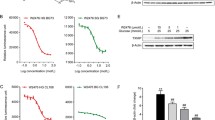Abstract
Since many Zn complexes have been developed to enhance the insulin-like activity and increase the exposure and residence of Zn in the animal body, these complexes are recognized as one of the new candidates with action mechanism different from existing anti-diabetic drugs. However, the molecular mechanism by which Zn complexes exert an anti-DM effect is unknown. Therefore, we evaluated the activity of Zn complexes, especially related to the phosphorylation of insulin signaling pathway components. We focused on the insulin-like effects of the bis(hinokitiolato)zinc complex, [Zn(hkt)2], using 3T3-L1 adipocytes. [Zn(hkt)2] was taken up by cells and induced Akt phosphorylation in a time-dependent manner. Additionally, it showed inhibitory activity against PTP1B and PTEN, which are major negative regulators of insulin signaling. It did not promote the phosphorylation of IR (insulin receptor)-β or IRS (insulin receptor substrate)-1 by itself, but in combination with insulin, it enhanced the phosphorylation of IRβ. We conclude that [Zn(hkt)2] has effects on the proteins of insulin signaling pathway without insulin receptor mediation, and [Zn(hkt)2] promotes insulin function and shows the anti-DM effects. Thus, [Zn(hkt)2] may be the basis for improved DM treatments.









Similar content being viewed by others
References
International Diabetes Federation (2014) IDF Diabetes ATLAS 6th edition
Tancredi M, Rosengren A, Svensson AM, Kosiborod M, Pivodic A, Gudbjörnsdottir S, Wedel H, Clements M, Dahlqvist S, Lind M (2015) N Engl J Med 373:1720–1732
Clegg MS, Hanna LA, Niles BJ, Momma TY, Keen CL (2005) IUBMB 57:661–669
Wätjen W, Haase H, Biagioli M, Beyersmann D (2002) Environ Health Perspect Suppl 110:865–867
Yamasaki S, Sakata-Sogawa K, Hasegawa A, Suzuki T, Kabu K, Sato E, Kurosaki T, Yamashita S, Tokunaga M, Nishida K, Hirano T (2007) J Cell Biol 177:637–645
Hirano T, Murakami M, Fukada T, Nishida K, Yamasaki S, Suzuki T (2008) Adv Immunol 97:149–176
Fukada T, Yamasaki S, Nishida K, Murakami M, Hirano T (2011) J Biol Inorg Chem 16:1123–1134
Tremblay F, Richard AM, Will S, Syed J, Stedman N, Perreault M, Gimeno RE (2009) Endocrinology 150:2586–2595
Dong X, Tang S, Zhang W, Gao W, Chen Y (2016) J Recept Signal Transduct Res 36:130–138
Cohen L, Asraf H, Sekler I, Hershfinkel M (2012) J Biol Chem 287:33339–33350
Cunningham JJ, Fu A, Mearkle PL, Brown RG (1994) Metabolism 43:1558–1562
Quilliot D, Dousset B, Dubois F, Drouin P, Ziegler O (2001) Pancreas 22:299–306
Takita S, Wakamoto Y, Kunitsugu I, Sugiyama S, Okuda M, Houbara T (2004) J Toxicol Sci 29:195–199
Jansen J, Karges W, Rink L (2009) J Nutr Biochem 20:399–417
Coulston L, Dandona P (1980) Diabetes 29:665–667
Shisheva A, Gefel D, Shechter Y (1992) Diabetes 41:982–988
Yoshikawa Y, Ueda E, Kawabe K, Miyake H, Sakurai H, Kojima Y (2000) Chem Lett 8:874–875
Sakurai H, Katoh A, Yoshikawa Y (2006) Bull Chem Soc Jpn 79:1645–1664
Yoshikawa Y, Yasui H (2012) Curr Top Med Chem 12:210–218
Fujimoto S, Yasui H, Yoshikawa Y (2013) J Inorg Biochem 121:10–15
Yoshikawa Y, Ueda E, Kojima Y, Sakurai H (2004) Life Sci 75:741–751
Ezaki O (1989) J Biol Chem 264:16118–16122
Tang X, Shay NF (2001) J Nutr 131:1414–1420
Naito Y, Yoshikawa Y, Yasui Y (2011) Bull Chem Soc Jpn 84:298–305
Yamane M, Adachi Y, Yoshikawa Y, Sakurai H (2005) Chem Lett 34:1694–1695
Basuki W, Hiromura M, Adachi Y, Tayama K, Hattori M, Sakurai H (2006) Biochem Biophys Res Commun 349:1163–1170
Hiromura M, Nakayama A, Adachi Y, Doi M, Sakurai H (2007) J Biol Inorg Chem 12:1275–1287
Haase H, Maret W (2003) Exp Cell Res 291:289–298
Haase H, Maret W (2005) Biometals 18:333–338
Yoshikawa Y, Ueda E, Miyake H, Sakurai H, Kojima Y (2001) Biochem Biophys Res Commun 281:1190–1193
Carraway RE, Dobner PR (2012) Biochim Biophys Acta 1823:544–557
Kim S, Jung Y, Kim D, Koh H, Chung J (2000) J Biol Chem 275:25979–25984
White MF (2003) Science 302:1710–1711
Seely BL, Staubs PA, Reichart DR, Berhanu P, Milarski KL, Saltiel AR, Kusari J, Olefsky JM (1996) Diabetes 45:1379–1385
Maehama T, Dixon JE (1998) J Biol Chem 273:13375–13378
Maehama T, Dixon JE (1999) Trends Cell Biol 9:125–128
Nakashima N, Sharma PM, Imamura T, Bookstein R, Olefsky JM (2000) J Biol Chem 275:12889–12895
Plum LM, Brieger A, Engelhardt G, Hebel S, Nessel A, Arlt M, Kaltenberg J, Schwaneberg U, Huber M, Rink L, Haase H (2014) Metallomics 6:1277–1287
Moroki T, Yoshikawa Y, Yoshizawa K, Tsubura A, Yasui H (2014) Metallomics 6:1632–1638
Jakusch T, Gajda-Schrantz K, Adachi Y, Sakurai H, Kiss T, Horváth L (2006) J Inorg Biochem 100:1521–1526
Reichle RA, McCurdy KG, Hepler LG (1975) Can J Chem 53:3841–3845
Haase H, Hebel S, Engelhardt G, Rink L (2015) Metallomics 7:102–111
Quattrin T, Bélanger A, Bohannon NJV, Schwarts SL (2004) The Exubera phase III study group. Diabetes Care 27:2622–2627
Acknowledgments
The authors are deeply grateful to members of the Department of Analytical and Bioinorganic Chemistry, Division of Analytical and Physical Sciences of Kyoto Pharmaceutical University. Additionally, the authors would like to express their gratitude to Akihiro Hiraki, Ph.D. and Kentaro Nishida, Ph. D. of Kyoto Pharmaceutical University for their technical advice and kind cooperation.
This study was financially supported in part by a Grant from the Ministry of Education, Culture, Sports, Science, and Technology of Japan (MEXT) Supported Program for the Strategic Research Foundation at Private Universities, 2012–2016 (S1201008). This work was also supported by JSPS KAKENHI Grant Numbers 25460048 (to YY) and 26460636 (to HY).
Author information
Authors and Affiliations
Corresponding authors
Electronic supplementary material
Below is the link to the electronic supplementary material.
Rights and permissions
About this article
Cite this article
Naito, Y., Yoshikawa, Y., Masuda, K. et al. Bis(hinokitiolato)zinc complex ([Zn(hkt)2]) activates Akt/protein kinase B independent of insulin signal transduction. J Biol Inorg Chem 21, 537–548 (2016). https://doi.org/10.1007/s00775-016-1364-9
Received:
Accepted:
Published:
Issue Date:
DOI: https://doi.org/10.1007/s00775-016-1364-9




